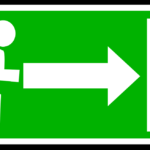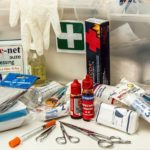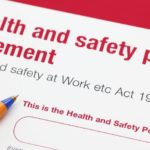First Aid Regulations UK
Does your business comply with First Aid Regulations?
An astonishing 80% of UK businesses have been found to be non compliant with UK first aid at work regulations. Is your business one of them?
According to the HSE, a total of 147 workers died in an accident at work in figures collated for the period 2018/19, but the average death toll over the past 5 years has been 142 annually.
And the biggest cause of fatal injury in the UK? Falls from height. These account for the majority of work related deaths. Closely followed by death from a moving vehicle.
During the same period that these figures were collated in 2018/19, a whopping 581,000 people in the UK were injured (non fatal) whilst at work.
These figures help to demonstrate why it’s essential that health and safety laws, and in particular first aid regulations are adhered to – so as to prevent serious injury and death.
Your business could face prosecution by the HSE should an employee become ill, seriously injured or even die whilst working for you if fail to follow first aid regulations and procedure.
As an employer, you have certain legal duties when it comes to health and safety legislation, and therefore, so complying with first aid regulations and managing injuries or illness at work is just one of these duties.
Following first aid guidelines can save lives and will help prevent minor injuries from becoming more serious.
In this article we will set out all you need to know about the first aid regulations and how you can ensure your business is fully compliant.
Health and Safety First Aid Regulations 1981
The Health and Safety First Aid Regulations 1981 were put in place to ensure that employers provide the correct equipment, facilities and trained staff in the event of employees taking ill or becoming injured whilst at work, so that they receive the correct and immediate medical attention in these circumstances.
First aid regulations apply to all types of workplaces, so it doesn’t matter if you’re self employed or have less than 5 employees, they’re still applicable to your business, and so by law you have to adhere to them.
However, depending on your specific type of business or workplace, there will be different requirements set out in these first aid regulations.
For example, you may or may not be required to have a dedicated first aid room or a trained first aider on site.
Dependent on the number of employees, you will also have different requirements for first aid kits and equipment.
For instance, if your workplace is small and considered to be low risk, such as an office with only 5 employees, then you only need to have a first aid box.
A person will also need to be appointed (such as an Office Manager) to be responsible for making any arrangements for first aid eg keeping the first aid box well stocked, calling the emergency services and so on.
There is no legal requirement for this appointed person to be trained in first aid.
However, the larger the business, the more employees and workplace health and safety risks, the more likelihood there is of needing to have one or more trained first aiders on site.
Whether your business is small or large, all employees must be made fully aware of any arrangements that are in place for first aid.

Assessing First Aid Requirements
In order to determine what first aid provisions you need to make for your business, you will need to carry out a full risk assessment.
This will involve assessing the health and safety risks already present in your workplace, the number of employees and the nature of your workforce and business.
Consideration will also have to be given to any work patterns of staff, accident history and any holidays that the appointed first aider(s) have planned so that alternative first aid arrangements can be made in their absence.
Employers may also have to take other important factors into consideration when assessing first aid requirements such as:-
- Workers both on and off site that are either working alone, remotely, on multi sites or travelling long distances as part of their job.
- Distance of your workplace to the nearest hospital or emergency service.
- How you will provide first aid to anyone not directly employed by you should they become ill or injured on your premises.
Employers are only legally required to make these provisions for their employees and not the general public, visitors to site etc. However, it is still highly recommended that they do so by the HSE.
First Aid Risk Categories
Typically, businesses will fall into 3 categories as in the table below of low risk, medium risk and high risk – employers will have to assess which category their business belongs to.
LOW RISK
Offices
Small Retail
Small Vehicles
Motorbikes
Small Pubs
Restaurants
Takeaway Food
Craft Manufacturing
Self Employed
Loan Workers (low risk)
High Technology
MEDIUM RISK
Public Buildings
Large Retail (incl banking)
Public Service Vehicles
Sports Teams
Hotels
Large Pubs/Restaurants
General Transportation
Beauty and Hairdressing
Arenas
Cinemas
Theatres
Plumbing
Water Services
Nursing Homes
Tourism (general)
Laundrettes
Holiday Parks
Education
Loan Workers (med risk)
Bus and Coach Terminals
HIGH RISK
Construction
Petrochemical Storage
Food Processing
Engineering
Waste Processing
Petrol Stations
Air Transportation
Refineries/Oil Production
General Manufacturing
Welding
Electricity Maintenance
Gas Maintenance
Power Stations
Forestry
Paper Mills
Foundries
Aerospace
Fisheries
Shipping
Pharmaceuticals
Rail Transportation
Need more guidance on the regulations of first aid at work? Visit the HSE website to download a copy of the full Health and Safety (First-Aid) Regulations 1981.
Making First Aid Arrangements in compliance with regulations
Once you have ascertained which risk category your business falls into (low, medium or high) and have conducted a full first aid needs risk assessment specific to your business, the next step is to finalise your first aid arrangements.
Every business is different, so depending on the size and type of business, your first aid arrangements will vary according to your specific needs.
After completing the risk assessment you should have a clear understanding of what provisions need to be made for any equipment such as first aid kits, what facilities you need to provide and how many of your staff will need to be appointed to make first aid arrangements or be trained in first aid.
The HSE have enforced minimum requirements for businesses with up to 50 employees, meaning you must have the following first aid arrangements in place:-
- you must have a well stocked first aid kit containing all the essentials to cater for the number of employees you have
- you must ensure there is person appointed to take charge of and manage first aid arrangements
- all employees must be supplied with information detailing first aid arrangements in the workplace.
Depending on the outcome of your risk assessment, your workforce needs may be more complex or it may highlight additional hazards in the workplace, meaning you will need to make provisions for more first aid equipment, facilities and trained first aiders in order to comply with the regulations.
Choosing Appointed Persons and First Aiders
It may be that your risk assessment highlights that your business is small enough that it doesn’t require a trained first aider in order to comply with first aid regulations.
However, you still need to appoint a single person to be responsible for any first aid arrangements, so that in an emergency they will call the ambulance and they have overall responsibility at all times for looking after the first aid kit and equipment, keeping everything well stocked and keeping records as necessary.
The person chosen for this task must be available at all times, and arrangements should be made for someone else to take over responsibility if they are going to be absent from work for whatever reason.
Larger businesses with 5 staff or more will need to appoint a dedicated first aider, and this person must receive the appropriate training for emergency first aid at work and hold a certificate.

Provision of First Aid Equipment and Facilities
Every business must provide at least one first aid kit as a minimum, and the larger the workplace or workforce, the more first aid kits will be required.
First aid kits have to be kept well stocked with the correct materials in accordance with the regulations and be kept in a safe place that can be accessed easily in a medical emergency.
Again, dependent on your business’s needs, you may need to stock additional first aid equipment such as foil blankets, a defibrillator, larger bandages/slings and more.
If you need help in determining exactly what items need to be in your first aid kit, then the HSE have published a guide on first aid equipment which you will find very useful.
First Aid Rooms
When it comes to facilities, your risk assessment may tell you that you need to provide a dedicated room for delivering first aid.
Although, it is usually only larger business premises that will require a first aid room or those businesses where there are higher risks to health and safety.
Does your risk assessment indicate that you need a first aid room? Then you must ensure that the room chosen for first aid purposes adheres to certain criteria as outlined in the regulations.
Whichever room you choose for this purpose has to be solely used for first aid and should be easily accessible to all staff at all times during working hours.
Also, it needs to be a good size to be able to carry out first aid procedures comfortably, be well ventilated and heated, have good lighting, be kept clean and tidy and preferably have surfaces and a sink with running water (both hot and cold).
One person should be given overall responsibility for supervising the first aid room.
Any room used for the sole purpose of first aid must have a sign on the door and display a notice giving the names, locations and contact details for emergency first aiders.
Reporting of incidents and accidents at work
Together with carrying out first aid requirement assessments and making arrangements and provisions, you must also ensure that any details of injuries or accidents are recorded as part of the regulations, and where necessary are reported to the HSE.
Under UK health and safety law known as RIDDOR (Reporting of Injuries, Diseases and Dangerous Occurrences Regulations 2013), all employers have a duty to report any serious accidents or dangerous occurrences in the workplace, including any cases of occupational diseases.
Not only is the recording of incidents a requirement by law, but it also helps you to keep track of any accidents and adjust your risk assessment and health and safety policies as necessary.
And keeping records is also essential should any employee attempt to make a claim against your company in the future for compensation – you will be able to prove compliance with first aid and health and safety regulations.
For more detailed guidance on keeping accident records and the reporting of incidents at work, please refer to the specific RIDDOR guidance on the HSE website.
Online First Aid courses
Here at UK online training, we provide the following first aid courses:-
Need help in finding the right First Aid at Work online training course? Then complete the contact form on this page our give us a call on 0161 763 3727 and we’ll be happy to assist.
Other articles you may find interesting…
- Health & safety legislation UK FREE On-line course Certificate & Support
 Are you a business owner needing to know more about health and safety legislation in the UK? This article sets out your legal responsibilities under UK law.
Are you a business owner needing to know more about health and safety legislation in the UK? This article sets out your legal responsibilities under UK law. - Fire safety in the workplace

 Business owners, Landlords, commercial property owners & managers must follow strict regulations for fire safety in the workplace in the UK. Read our article to find out what your responsibilities are.
Business owners, Landlords, commercial property owners & managers must follow strict regulations for fire safety in the workplace in the UK. Read our article to find out what your responsibilities are. - Display Screen Equipment Awareness online training

 Are you a business owner needing to know more about health and safety legislation in the UK? This article sets out your legal responsibilities under UK law.
Are you a business owner needing to know more about health and safety legislation in the UK? This article sets out your legal responsibilities under UK law. - First Aid Regulations UK

 Are you a UK employer and wondering what you must do to comply with the first aid regulations? This article will explain what you need to know and do.
Are you a UK employer and wondering what you must do to comply with the first aid regulations? This article will explain what you need to know and do. - Workplace Health and Safety


 Business owners, Landlords, commercial property owners & managers must follow strict regulations for fire safety in the workplace in the UK. Read our article to find out what your responsibilities are.
Business owners, Landlords, commercial property owners & managers must follow strict regulations for fire safety in the workplace in the UK. Read our article to find out what your responsibilities are. - Working Safely training course

 Business owners, Landlords, commercial property owners & managers must follow strict regulations for fire safety in the workplace in the UK. Read our article to find out what your responsibilities are.
Business owners, Landlords, commercial property owners & managers must follow strict regulations for fire safety in the workplace in the UK. Read our article to find out what your responsibilities are.
